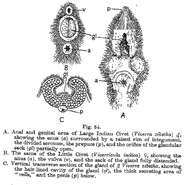Scent glands
| Scent gland | |
|---|---|

|
|

The arrow is pointing to the metatarsal gland of a Sika deer
|
|
| Details | |
| Latin | glandula odorifera |
|
Anatomical terminology
[]
|
|
Scent glands are exocrine glands found in most mammals. They produce semi-viscous secretions which contain pheromones and other semiochemical compounds. These odor-messengers indicate information such as status, territorial marking, mood, and sexual power. The odor may be subliminal—not consciously detectable. Though it is not their primary function, the salivary glands may also function as scent glands in some animals.
The even-toed ungulates (Artiodactyla) have many specialized skin glands, the secretions of which are involved in semiochemical communication. These glands include the sudoriferous glands (located on the forehead, between the antlers and eyes), the preorbital glands (extending from the medial canthus of each eye), the nasal glands (located inside the nostrils), the interdigital glands (located between the toes), the preputial gland (located inside the foreskin of the penis), the metatarsal glands (located outside of the hind legs), and the tarsal glands (located inside of the hind legs).
Like many other species of Artiodactyla, deer have seven major external scent glands distributed throughout their bodies. Deer rely heavily on these scent glands to communicate with other members of their species, and possibly even with members of other species. For example, male white-tailed deer (Odocoileus virginianus) are often seen working over a scrape. First, the animal scrapes at the dirt with its hooves, depositing the scent from his interdigital gland on the ground. After that, he may bite the tip off an overhanging branch, depositing secretions from his salivary glands onto the branch. He may then rub his face on the overhanging branch, depositing secretions from the sudoriferous and preorbital glands on it.
...
Wikipedia
